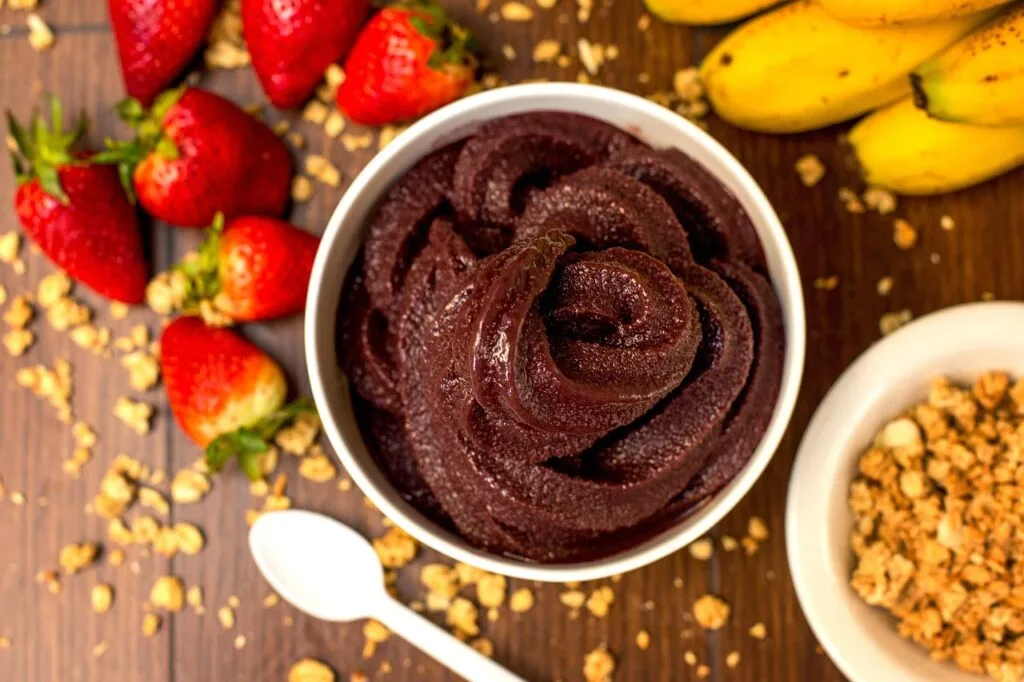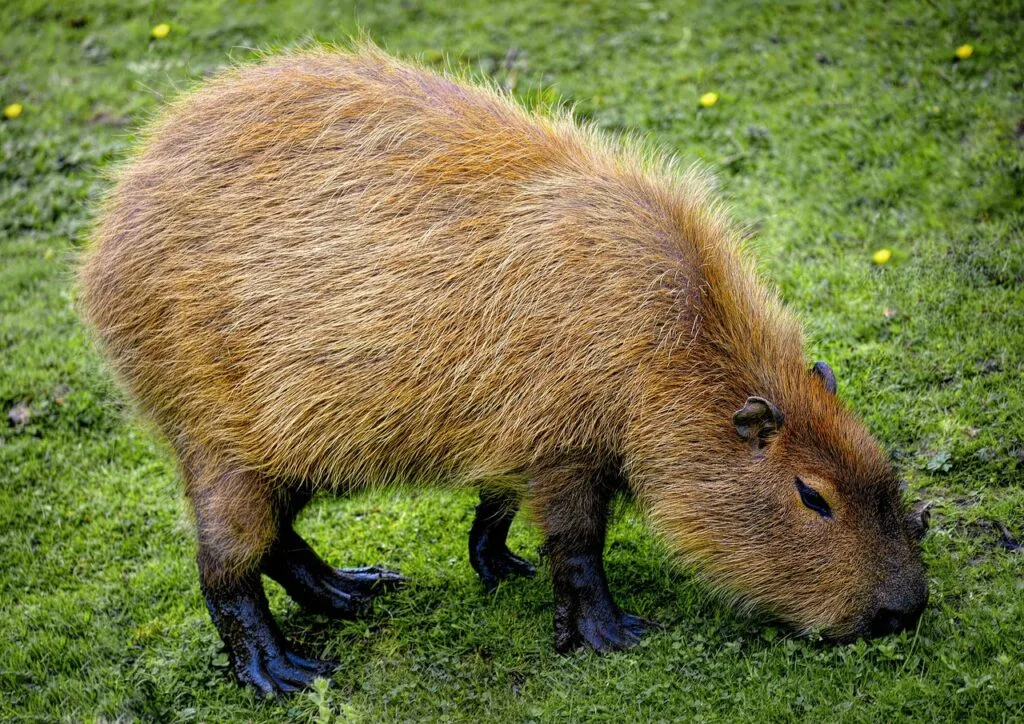Brazil is a continental-sized country that holds unique secrets from around the world. When we talk about things that only exist in Brazil, we’re not just mentioning curiosities, but genuine elements of our culture, nature, and creativity that were born on Brazilian soil and remained exclusively ours. Get ready to discover a universe of particularities that make Brazil a truly singular destination on the planet.
Brazilian Nature in Its Most Exclusive Form
Açaí – The Amazonian Superfruit
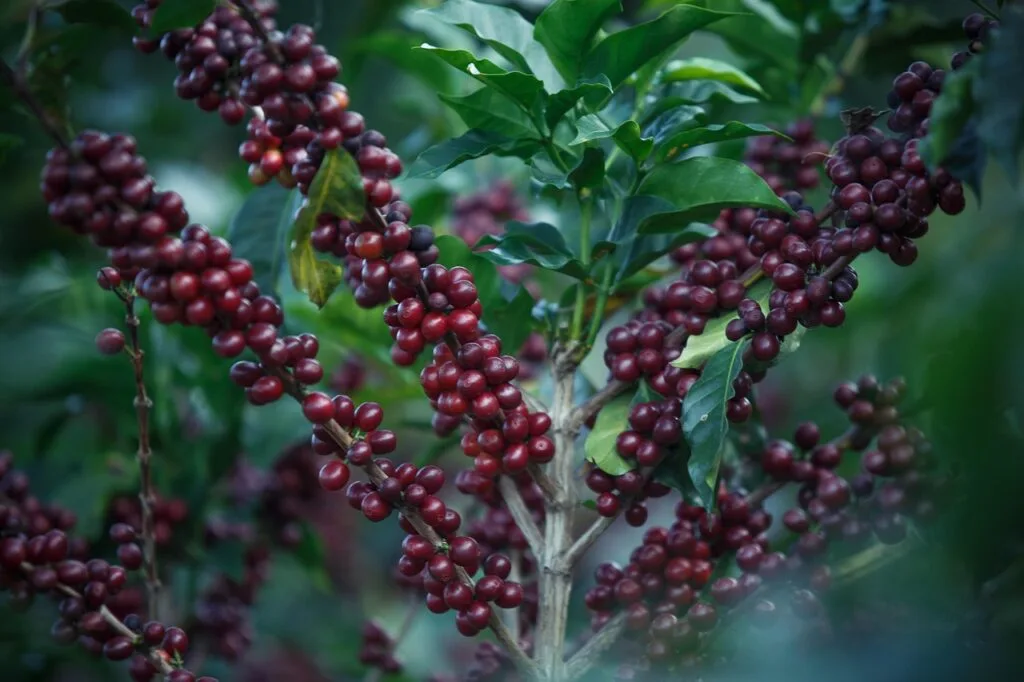
Açaí is much more than a fruit; it’s a symbol of the Brazilian Amazon. Although now known worldwide, açaí in its authentic form – served as a base for savory or sweet meals, accompanied by tapioca flour, dried shrimp, or fruits – is an experience that only exists in Brazil. In the North region, especially in Pará, açaí isn’t dessert, but rather a basic daily food.
The açaí palm (Euterpe oleracea) grows naturally only in the Amazon region, and the traditional preparation process, from harvesting to the “batedeiro” (special machine for extracting pulp), is an art passed down through generations among riverside communities.
Guaraná Antarctica – The National Soft Drink
While the world knows colas and citrus sodas, Brazil created its own category with Guaraná Antarctica. This soft drink, made with Amazonian guaraná extract (Paullinia cupana), has a unique flavor that finds no parallel anywhere else in the world. Guaraná is a plant native to the Amazon, and its transformation into a soft drink is a 100% Brazilian innovation that conquered the national palate.

Guaraná Antarctica isn’t just a beverage, but part of Brazilian cultural identity, present at barbecues, parties, and in the daily lives of families from north to south of the country.
Capybara – The World’s Largest Rodent
The capybara (Hydrochoerus hydrochaeris) is an animal exclusive to South America, but its striking and peaceful presence in Brazilian culture is unique. Found throughout practically the entire national territory, capybaras have become symbols of tranquility and adaptability, frequently seen in urban parks, golf courses, and even on the streets of some Brazilian cities.
Unlike other countries where they’re just wild animals, in Brazil capybaras have developed an almost harmonious relationship with urban centers, especially in cities like Brasília and regions of São Paulo’s interior, where their presence is accepted and even celebrated by the local population.
Exclusively Brazilian Cultural Expressions
Capoeira – The Martial Art That Is Dance
Capoeira is perhaps one of the most emblematic cultural creations among things that only exist in Brazil. Born from the resistance of enslaved Africans, capoeira combines fighting, dance, music, and life philosophy in a way unique to the world. Instruments like the berimbau, atabaque, and pandeiro create the soundtrack for this art that spreads in circles throughout Brazil.
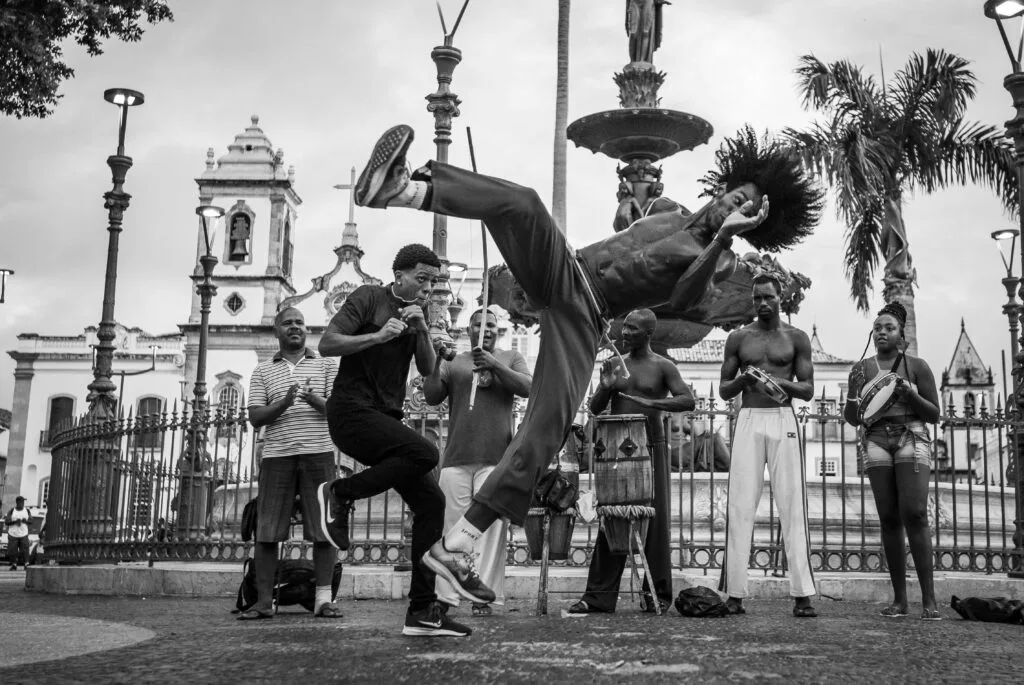
Different from any Asian martial art or European folk dance, capoeira has its own ginga, literally. The ginga is the base movement that defines all the rhythm and philosophy of capoeira, representing the cunning, elegance, and resistance of the Brazilian people.
Festa Junina – Brazilian-Style Saint John’s Festival
Although solstice festivals exist in various cultures, the Brazilian Festa Junina is unique in the world. The combination of Portuguese Catholic elements, indigenous traditions, and Brazilian creativity resulted in celebrations that don’t exist anywhere else. Quadrilha, mock country wedding, Saint John’s bonfire, quentão (hot spiced drink), pamonha (corn cake), boiled corn, and candy apple create a festive universe exclusively Brazilian.
In the Northeast, especially in Campina Grande and Caruaru, June festivals assume gigantic proportions, with forró, accordion, and traditions that have been perpetuated for generations.
Street Carnival – The Democracy of Celebration
Although several countries have carnival, the Brazilian Street Carnival, especially in Rio de Janeiro, Salvador, and Recife, is unique in the world. The way millions of people take over the streets, transforming entire cities into stages of democratic and inclusive celebration, doesn’t exist anywhere else.
The street blocks, with their original marching songs, creative costumes, and political irreverence, create a cultural experience that goes far beyond entertainment, becoming social, artistic, and resistance manifestation typically Brazilian.
Flavors That Don’t Exist Anywhere Else
Brigadeiro – The National Sweet
Brigadeiro is possibly the most Brazilian sweet that exists. Created in the 1940s, supposedly in honor of Brigadier Eduardo Gomes, this sweet made with condensed milk, cocoa powder, and butter, covered with chocolate sprinkles, is mandatory at Brazilian children’s parties.
Different from French truffles or Belgian chocolates, brigadeiro has unique texture and flavor, plus a simplicity that makes it accessible and democratic. Today there are variations like gourmet brigadeiro, spoon brigadeiro, and innovative flavors, but the essence remains exclusively Brazilian.
Coxinha – The Brazilian Savory
Coxinha is one of Brazil’s most ingenious culinary creations. This fried savory, with potato or wheat flour dough traditionally filled with shredded chicken and catupiry cheese, molded in a shape resembling a chicken thigh, is an exclusively Brazilian invention that conquered hearts and palates.
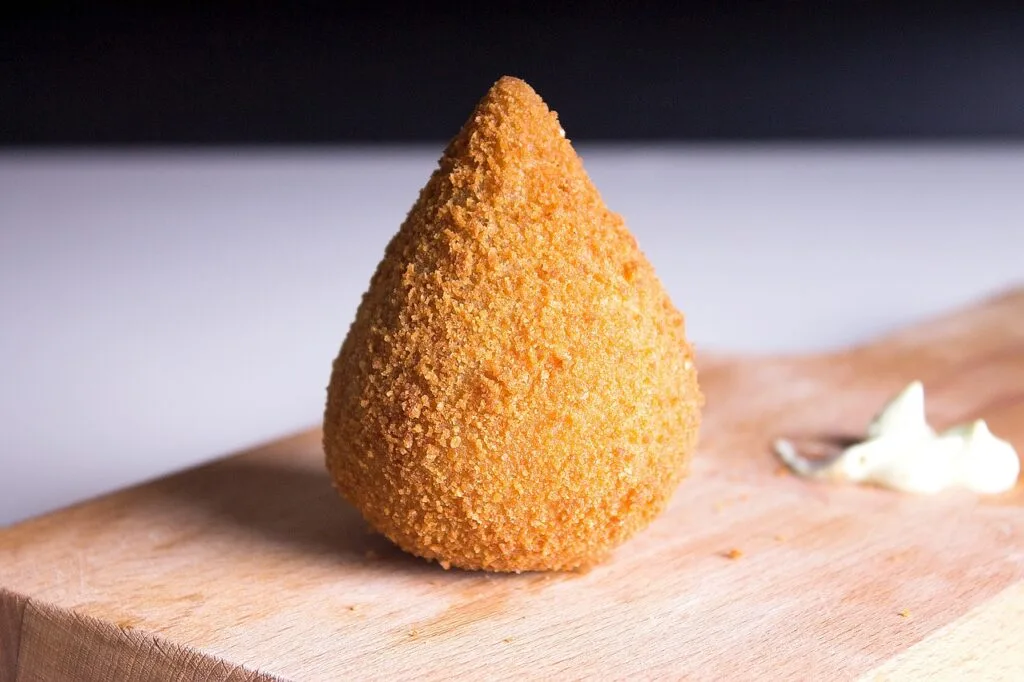
The technique of molding the dough, the balance between external crunchiness and internal creaminess, and the diversity of fillings that emerged from the original recipe make coxinha a national gastronomic heritage.
Pé de Moleque – June Festival Sweet
Pé de moleque is a traditional sweet made with peanuts and rapadura (brown sugar cake) or brown sugar that finds no similar anywhere else in the world. Its crunchy texture and intense flavor of roasted peanuts, combined with the sweetness of rapadura, create a unique gustatory experience of Brazilian June festivals.
Farofa – The National Side Dish
Farofa is one of Brazil’s most democratic and versatile culinary creations. Made with cassava flour (another typically Brazilian product), farofa can receive the most diverse ingredients: bacon, sausage, eggs, banana, raisins, olives, and much more.

The art of making farofa, with the right point of flour roasting and ingredient balance, is knowledge passed from generation to generation and varies from region to region, making each farofa unique.
Brazilian Innovations the World Doesn’t Know
Havaianas – The Sandals That Conquered the World
Havaianas were born in Brazil in 1962, inspired by Japanese zori sandals, but with a unique tropical adaptation. What began as simple, cheap footwear for the Brazilian population became a worldwide phenomenon, maintaining, however, its essence and Brazilian production.
The genius of Havaianas lies in democratizing comfort and the ability to transform a simple product into an icon of style and Brazilianness.
Buriti Oil – The Amazon’s Natural Sunscreen
Buriti oil, extracted from the Mauritia flexuosa palm, is a natural cosmetic product used for centuries by Amazonian populations as natural sunscreen. This oil has unique UV protection properties and is rich in beta-carotene, giving it a characteristic orange color.
Although the buriti palm exists in other South American countries, cosmetic use and oil commercialization are exclusively Brazilian practices.
Flip-Flop Culture – The Revolution on Feet
Even before Havaianas, Brazil had already popularized the use of flip-flops as everyday footwear. This adaptation of oriental footwear to the Brazilian tropical climate created a culture of comfortable and practical shoes that became a trademark of Brazilian casualness.
Uniquely Brazilian Social Traditions
Garage Barbecue – Suburban Socializing
The garage barbecue is a unique Brazilian social institution. Different from traditional Gaucho barbecue or American barbecues, the garage barbecue is an informal social event that happens in house garages, especially in Greater São Paulo and metropolitan regions.
This type of gathering combines music (frequently funk, sertanejo, or pagode), cold beer, grilled meat, and a totally relaxed atmosphere, creating unique social bonds in Brazilian urban culture.
Pelada – Grassroots Football
Pelada or várzea football is an exclusively Brazilian sporting cultural manifestation. Different from professional football or organized amateur football, pelada is football played on weekends on improvised fields, with flexible rules and much more focused on fellowship than competition.
Fields like those at Várzea do Carmo in São Paulo or the small fields scattered throughout Brazilian peripheries are cradles of talent and, mainly, spaces for masculine socialization typically Brazilian.
Samba Circle – Musical Democracy
The samba circle is an exclusively Brazilian musical and social tradition. Different from formal musical presentations, the samba circle is a spontaneous gathering where anyone can contribute with voice, instrument, or just clapping and energy.
Instruments like cavaquinho, pandeiro, tamborim, surdo, and cuíca create a rhythmic base on which develops a collective and improvised musical experience that represents the essence of Brazilian socialization.
Genuinely Brazilian Linguistic Expressions
Saudades – The Untranslatable Word
Although the word saudades exists in Portuguese, the way Brazilians use it, with its emotional nuances and daily applications, is unique. “I’m feeling saudades,” “saudades of home,” “what saudade” are expressions that carry an emotional charge specific to Brazilianness.
The ability to express through this word a feeling that combines nostalgia, love, melancholy, and hope is a particularity of the Brazilian way of communicating and feeling.
Jeitinho Brasileiro – The Art of Solving the Impossible
The jeitinho brasileiro (Brazilian way) is more than an expression; it’s a life philosophy that permeates national culture. This ability to find creative solutions to apparently insurmountable problems, always with a smile and goodwill, is one of the characteristics of things that only exist in Brazil.
The jeitinho brasileiro represents the capacity for adaptation, creativity, and humanization of relationships that permeates from small daily situations to great national challenges.
Affectionate Diminutives
The excessive and affectionate use of diminutives is a particularity of the Brazilian way of speaking. “Little coffee,” “little beer,” “little way,” “real quick,” “close by” are examples of how Brazilians soften and humanize language, creating a tone of intimacy and affection even in formal situations.
Exclusive Natural Phenomena
Lençóis Maranhenses – Desert That Isn’t Desert
The Lençóis Maranhenses, in Maranhão, are a unique geological and climatic phenomenon in the world. These white sand dunes that fill with crystal-clear water during the rainy season, creating temporary lagoons of surprising colors, don’t exist anywhere else on the planet.
The combination of tropical climate with dune formation creates landscapes that seem taken from a dream, where it’s possible to swim among dunes in the middle of what appears to be a desert.
Mata dos Cocais – Unique Ecosystem
The Mata dos Cocais (Palm Forest), a transition ecosystem between the Amazon and Caatinga, mainly in Maranhão and Piauí, is a unique biome in the world. Dominated by palms like babaçu, carnaúba, and buriti, this ecosystem sustains entire communities that have developed a unique relationship with these palms.
Chapada Diamantina – Otherworldly Landscapes
The Chapada Diamantina, in Bahia, presents rock formations, waterfalls, and caves that create unique landscapes in the world. The Enchanted Well, with its crystal-blue waters, and Smoke Waterfall are examples of natural beauties that only exist in this Brazilian region.
Unique Religious and Spiritual Manifestations
Umbanda – The Brazilian Religion
Umbanda is a genuinely Brazilian religion, born from syncretism between elements of Catholicism, Afro-Brazilian religions, Kardecist spiritism, and indigenous traditions. This unique combination created a religious practice that doesn’t exist anywhere else in the world.
The umbanda temples, with their sung points, spiritual sessions, and spirit incorporations, represent one of the most authentic expressions of Brazilian religiosity.
Iemanjá Festival – Devotion to Waters
Although Iemanjá is a divinity of African origin, the way she’s celebrated in Brazil, especially in Bahia and Rio de Janeiro, is unique in the world. The offerings of white flowers to the sea, gifts left on the beach, and the popular celebration that forms around this devotion create a typically Brazilian religious manifestation.
Exclusive Artistic Creations
Cordel – Popular Literature
Cordel literature is a form of popular artistic expression exclusively Brazilian, especially strong in the Northeast. These pamphlets with rhymed stories, illustrated with woodcuts, tell everything from epic narratives to everyday events with humor and popular wisdom.
The tradition of hanging cordels on strings (hence the name) at fairs and public squares created a unique form of democratizing literature that doesn’t exist in other countries.
Repente – Improvised Poetry
Repente or cantoria is an exclusively Brazilian poetic and musical art, mainly from the Northeast. Two singers, accompanied by viola or rabeca, improvise rhymed verses on any theme proposed by the audience, creating a poetic competition that mixes intelligence, humor, and musical skill.
Northeastern Woodcut – Unique Popular Art
Northeastern woodcut, especially that produced in Juazeiro do Norte and region, developed unique aesthetic characteristics in the world. The striking lines, regional themes, and technique adapted to available materials created an artistic school that influenced national and international aesthetic movements.
Brazilian Sports Modalities
Footvolley – The Carioca Innovation
Footvolley was born on the beaches of Rio de Janeiro as an adaptation of football and volleyball to beach sand. This sport, which combines football’s foot skills with adapted volleyball rules, is a 100% Brazilian creation that now spreads worldwide.
The technique of playing volleyball only with feet, chest, head, and shoulders, without using hands, requires a unique skill that represents Brazilian sporting creativity.
Frescobol – The Sport of Cooperation
Frescobol is another exclusively Brazilian beach sport. Different from other racket sports, in frescobol players cooperate to keep the ball in the air as long as possible, creating a unique sporting philosophy based on partnership instead of competition.
Unique Musical Instruments
Berimbau – The Brazilian Musical Bow
The berimbau, capoeira’s main instrument, is a Brazilian adaptation of African musical bows. Its construction with biriba (Brazilian wood), steel wire, gourd, and caxixi created a unique instrument that produces sounds impossible to replicate with other instruments.
The technique of playing berimbau, with its specific toadas that command capoeira movements, is exclusively Brazilian knowledge.
Cuíca – The Drum That Sings
The cuíca is a unique percussion instrument in the world. Its characteristic sound, produced by friction of a stick on the tensioned drum skin, creates sound effects that don’t exist in any other musical instrument.
Essential in samba and choro, the cuíca represents Brazilian genius in transforming simple elements into complex and expressive artistic creations.
The Brazilianness That Enchants the World
The things that only exist in Brazil are testimonies to creativity, resistance, and joy of living that arise from cultural miscegenation, natural abundance, and Brazilian capacity to transform adversities into art, flavor, and tradition.
From Amazonian açaí to Bahian capoeira, from children’s party brigadeiro to Lençóis Maranhenses, Brazil offers the world genuine experiences that cannot be found anywhere else on the planet.
Each of these particularities tells the story of a people who knew how to create, from diverse influences, something completely new and authentic. These exclusivities make Brazil not just a tourist destination, but a unique cultural universe, where each region, each tradition, and each flavor carries the essence of a Brazilianness that, once experienced, is never forgotten.
The richness of things that only exist in Brazil goes far beyond folklore or tourist curiosities. It represents human capacity to create, adapt, and innovate when different cultures meet in a territory of natural abundance and climatic diversity. It’s living proof that creativity knows no borders and that joy of living can manifest in the most surprising and authentic ways.
When you get to know Brazil, you won’t just be visiting a country; you’ll be diving into a world of experiences that exist only here, created by a people who transformed diversity into unity and difficulties into joy of living. Each of these Brazilian exclusivities is an invitation to discover that in Brazil, the impossible becomes everyday and the everyday transforms into art.

